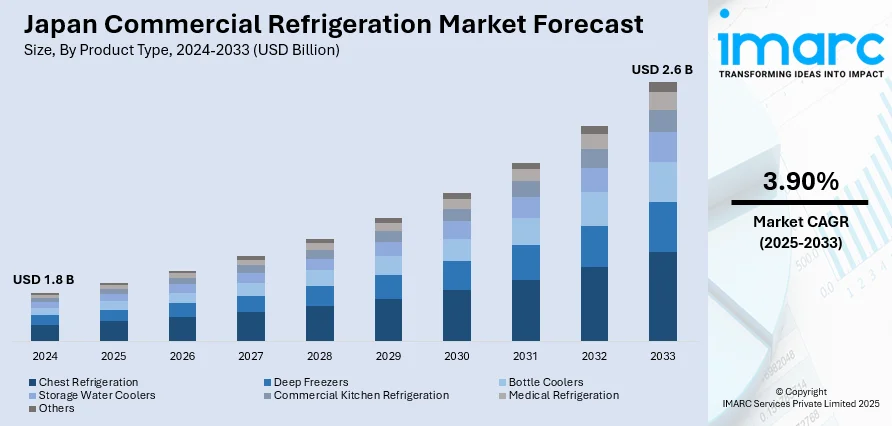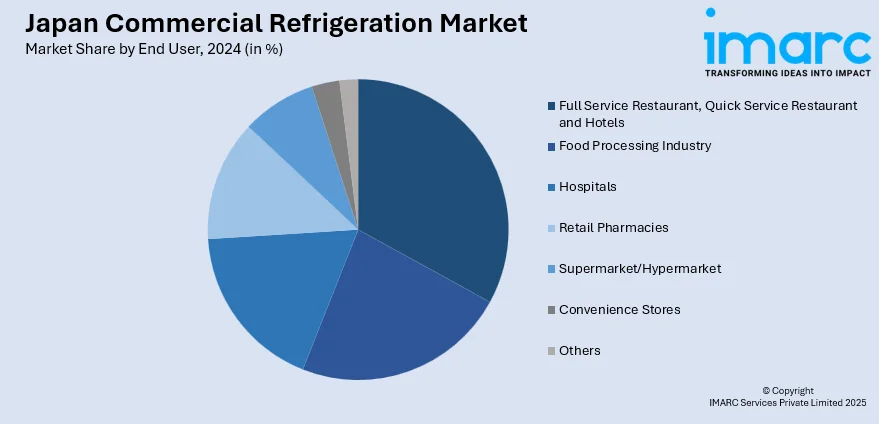
Japan Commercial Refrigeration Market Size, Share, Trends and Forecast by Product Type, End User, and Region, 2025-2033
Japan Commercial Refrigeration Market Overview:
The Japan commercial refrigeration market size reached USD 1.8 Billion in 2024. Looking forward, IMARC Group expects the market to reach USD 2.6 Billion by 2033, exhibiting a growth rate (CAGR) of 3.90% during 2025-2033. The market is driven by the expansion of food retail and convenience stores, technological advancements emphasizing energy efficiency and smart systems, stringent environmental regulations promoting eco-friendly refrigerants, and the growing demand from the healthcare sector for reliable biomedical refrigeration solutions.
|
Report Attribute
|
Key Statistics
|
|---|---|
|
Base Year
|
2024 |
|
Forecast Years
|
2025-2033
|
|
Historical Years
|
2019-2024
|
| Market Size in 2024 | USD 1.8 Billion |
| Market Forecast in 2033 | USD 2.6 Billion |
| Market Growth Rate 2025-2033 | 3.90% |
Japan Commercial Refrigeration Market Trends:
Technological Advancements and Energy Efficiency Regulations
Japan's emphasis on innovation has accelerated the integration of smart refrigeration systems, using IoT and AI for real-time monitoring, predictive maintenance, and temperature optimization. These advancements reduce energy consumption and operating costs, aligning with Japan’s national goal of achieving carbon neutrality by 2050. Moreover, regulations under the Act on Rational Use and Proper Management of Fluorocarbons mandate the shift away from high-GWP refrigerants. In response, manufacturers are developing energy-efficient, low-emission systems using natural refrigerants like CO₂ and hydrocarbons. These technologies meet regulatory standards and also appeal to eco-conscious consumers and businesses, making them a vital factor in driving the Japan commercial refrigeration market growth.

Growth of the Biomedical and Healthcare Sectors
Japan's aging population and expanding medical infrastructure have significantly increased the demand for commercial refrigeration in healthcare. Hospitals, clinics, pharmaceutical companies, and research labs require precise and reliable refrigeration for storing vaccines, biologics, and temperature-sensitive medications. In particular, the rollout of COVID-19 vaccines highlighted the importance of robust cold chain infrastructure, prompting further investment in biomedical refrigeration systems. This demand is sustained by ongoing developments in biotechnology and pharmaceutical research, thus fueling the Japan commercial refrigeration market share. The healthcare sector's reliance on constant temperature control and regulatory compliance with safety standards continues to boost the adoption of specialized, high-performance refrigeration systems designed to support sensitive healthcare applications across the country.
Environmental Sustainability and Regulatory Compliance
Environmental sustainability plays a crucial role in Japan’s refrigeration market. The government promotes eco-friendly practices through strict regulations phasing out ozone-depleting substances and high-GWP refrigerants. Companies are increasingly adopting refrigeration systems using natural refrigerants like CO₂, ammonia, and hydrocarbons to reduce environmental impact. These systems are supported by subsidies and incentives encouraging compliance with energy-efficiency standards. Rising consumer awareness and corporate ESG goals are also pushing businesses to invest in sustainable refrigeration technologies, creating a positive impact on Japan commercial refrigeration market outlook. As Japan continues to lead in climate-conscious policy implementation, sustainability requirements will remain a central factor influencing purchasing decisions and technological innovation in commercial refrigeration.
Japan Commercial Refrigeration Market Segmentation:
IMARC Group provides an analysis of the key trends in each segment of the market, along with forecasts at the regional level for 2025-2033. Our report has categorized the market based on product type and end user.
Product Type Insights:
- Chest Refrigeration
- Deep Freezers
- Bottle Coolers
- Storage Water Coolers
- Commercial Kitchen Refrigeration
- Medical Refrigeration
- Others
The report has provided a detailed breakup and analysis of the market based on the product type. This includes chest refrigeration, deep freezers, bottle coolers, storage water coolers, commercial kitchen refrigeration, medical refrigeration, and others.
End User Insights:

- Full Service Restaurant, Quick Service Restaurant and Hotels
- Food Processing Industry
- Hospitals
- Retail Pharmacies
- Supermarket/Hypermarket
- Convenience Stores
- Others
A detailed breakup and analysis of the market based on the end user have also been provided in the report. This includes full service restaurant, quick service restaurant and hotels, food processing industry, hospitals, retail pharmacies, supermarket/hypermarket, convenience stores, and others.
Regional Insights:
- Kanto Region
- Kansai/Kinki Region
- Central/ Chubu Region
- Kyushu-Okinawa Region
- Tohoku Region
- Chugoku Region
- Hokkaido Region
- Shikoku Region
The report has also provided a comprehensive analysis of all the major regional markets, which include the Kanto Region, Kansai/Kinki Region, Central/ Chubu Region, Kyushu-Okinawa Region, Tohoku Region, Chugoku Region, Hokkaido Region, and Shikoku Region.
Competitive Landscape:
The market research report has also provided a comprehensive analysis of the competitive landscape. Competitive analysis such as market structure, key player positioning, top winning strategies, competitive dashboard, and company evaluation quadrant has been covered in the report. Also, detailed profiles of all major companies have been provided.
Japan Commercial Refrigeration Market News:
- In December 2024, HOSHIZAKI CORPORATION improved its commercial refrigerator, freezer, and refrigerator-freezer lines and will introduce 364 new models (251 upright and 113 under-counter models). This will allow the company to complete the conversion of refrigerant gases for all its standard models of commercial refrigerators, freezers, and refrigerator-freezers (the standard lineup)1 for the Japanese market from hydrofluorocarbons (HFCs) to low-impact natural refrigerants2 by the close of 2024. Hoshizaki will begin distributing the new models consecutively from mid-December and will market them through its 15 sales firms across the country.
Japan Commercial Refrigeration Market Report Coverage:
| Report Features | Details |
|---|---|
| Base Year of the Analysis | 2024 |
| Historical Period | 2019-2024 |
| Forecast Period | 2025-2033 |
| Units | Billion USD |
| Scope of the Report |
Exploration of Historical Trends and Market Outlook, Industry Catalysts and Challenges, Segment-Wise Historical and Future Market Assessment:
|
| Product Types Covered | Chest Refrigeration, Deep Freezers, Bottle Coolers, Storage Water Coolers, Commercial Kitchen Refrigeration, Medical Refrigeration, Others |
| End Users Covered | Full Service Restaurant, Quick Service Restaurant And Hotels, Food Processing Industry, Hospitals, Retail Pharmacies, Supermarket/Hypermarket, Convenience Stores, Others |
| Regions Covered | Kanto Region, Kansai/Kinki Region, Central/ Chubu Region, Kyushu-Okinawa Region, Tohoku Region, Chugoku Region, Hokkaido Region, Shikoku Region |
| Customization Scope | 10% Free Customization |
| Post-Sale Analyst Support | 10-12 Weeks |
| Delivery Format | PDF and Excel through Email (We can also provide the editable version of the report in PPT/Word format on special request) |
Key Questions Answered in This Report:
- How has the Japan commercial refrigeration market performed so far and how will it perform in the coming years?
- What is the breakup of the Japan commercial refrigeration market on the basis of product type?
- What is the breakup of the Japan commercial refrigeration market on the basis of end user?
- What is the breakup of the Japan commercial refrigeration market on the basis of region?
- What are the various stages in the value chain of the Japan commercial refrigeration market?
- What are the key driving factors and challenges in the Japan commercial refrigeration market?
- What is the structure of the Japan commercial refrigeration market and who are the key players?
- What is the degree of competition in the Japan commercial refrigeration market?
Key Benefits for Stakeholders:
- IMARC’s industry report offers a comprehensive quantitative analysis of various market segments, historical and current market trends, market forecasts, and dynamics of the Japan commercial refrigeration market from 2019-2033.
- The research report provides the latest information on the market drivers, challenges, and opportunities in the Japan commercial refrigeration market.
- Porter's five forces analysis assist stakeholders in assessing the impact of new entrants, competitive rivalry, supplier power, buyer power, and the threat of substitution. It helps stakeholders to analyze the level of competition within the Japan commercial refrigeration industry and its attractiveness.
- Competitive landscape allows stakeholders to understand their competitive environment and provides an insight into the current positions of key players in the market.
Need more help?
- Speak to our experienced analysts for insights on the current market scenarios.
- Include additional segments and countries to customize the report as per your requirement.
- Gain an unparalleled competitive advantage in your domain by understanding how to utilize the report and positively impacting your operations and revenue.
- For further assistance, please connect with our analysts.
 Request Customization
Request Customization
 Speak to an Analyst
Speak to an Analyst
 Request Brochure
Request Brochure
 Inquire Before Buying
Inquire Before Buying




.webp)




.webp)












